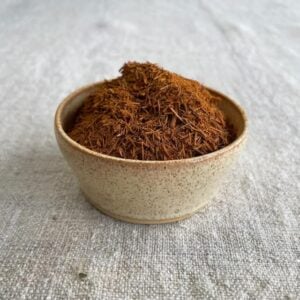
Sappanwood sawdust is native to SE Asia and India and produces pink and red results.
Fiber Preparation and Mordanting
We offer scouring and mordanting instructions for wool, alpaca, silk (protein), cotton and plant (cellulose) fibers. Your fiber should be scoured and mordanted before dyeing.
Extracting the Dye
For a deep red color, use between 50 and 100% sawdust on the weight of fiber (WOF).
We like to extract the color by simmering sappanwood sawdust in water for an hour, then letting it soak overnight. The next day, strain out the sawdust and reserve, then use the soaking water as your dye bath. You may add more water to the dye bath to cover the mordanted fibers.
Adding Fibers to the Pot
If the liquid from simmering the sawdust isn’t enough to cover your mordanted fibers, add more water so that they can move easily.
If you want to create magenta and fuchsia tones, add 1-2% WOF calcium carbonate (chalk) to the dye bath before adding the mordanted fibers.
Add the wet, mordanted fibers to the cold dye pot and begin heating the water and bring to about 160 degrees F, rotating the goods gently. Hold at this temperature for 45 minutes, rotating the fiber regularly.
Rinsing
Using the same temperature water as your dye bath, rinse the dyed goods once or twice to remove excess dye, then wash gently in a neutral liquid soap. Dry away from direct sunlight.
Reusing Dye Baths and Disposal of Dye
Any exhaust baths with dye color left in them may be used to dye additional materials. I keep extra small skeins of mordanted wool yarn and throw those into the exhaust baths. There will usually be some residual color in the dyebath, even after using the exhaust bath. Dispose of the used dye baths in accordance with your local municipal guidelines.


